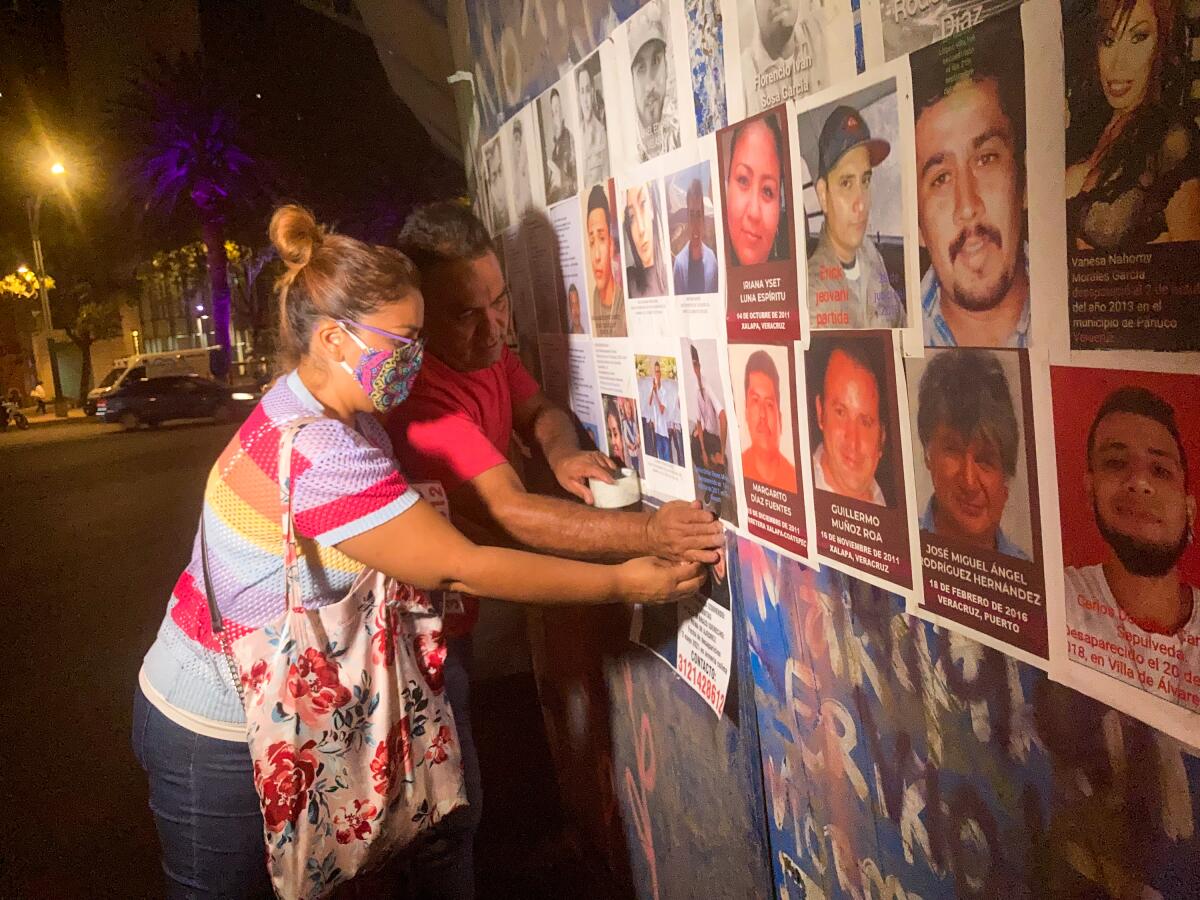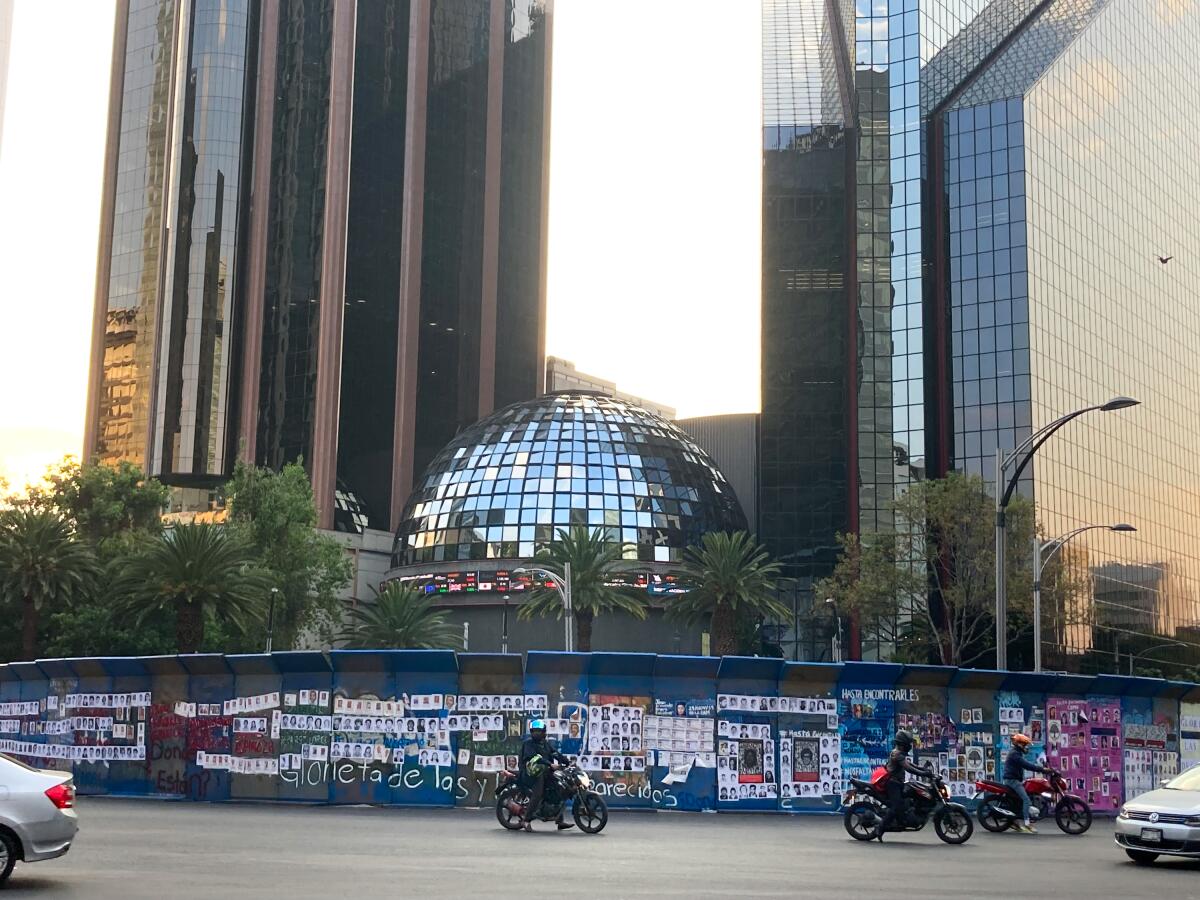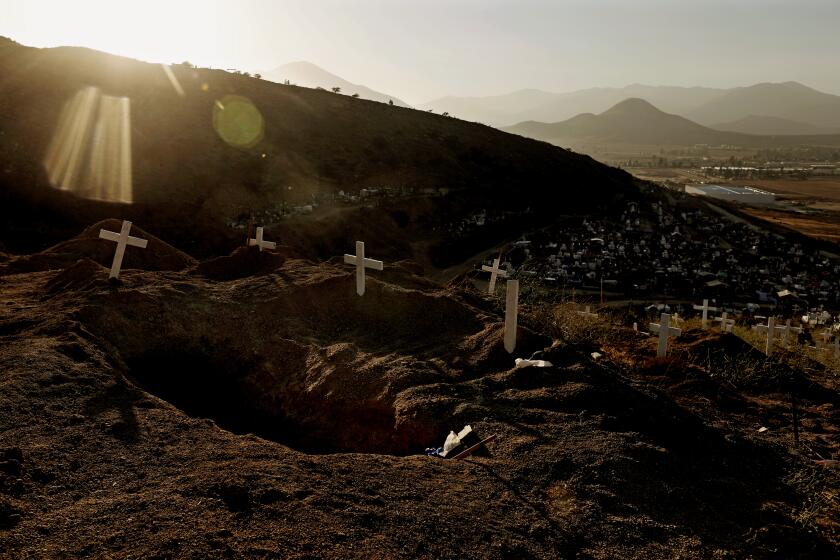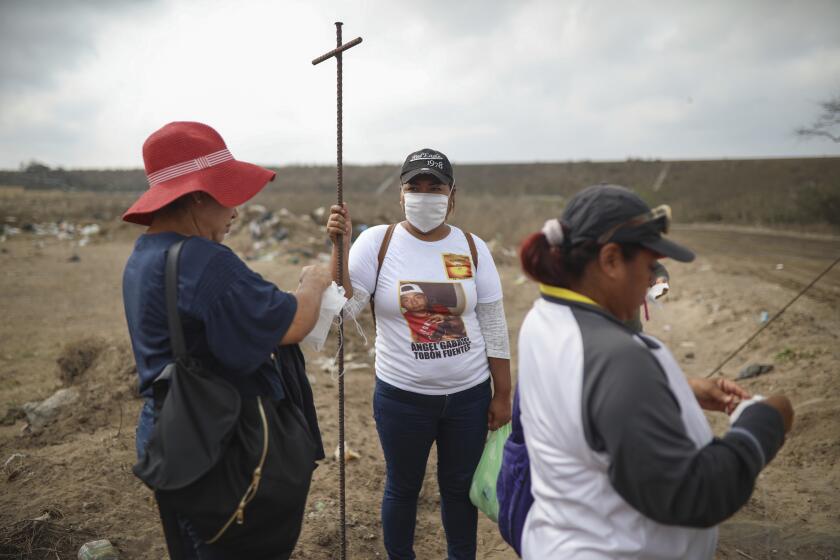‘No one else cares’: Families of the 100,000 missing in Mexico seek to be heard

- Share via
MEXICO CITY — Families took to WhatsApp to quietly spread word about the demonstration they were planning.
They met on a recent Sunday in Mexico City, gathering at a roundabout on Paseo de la Reforma, the capital’s signature boulevard.
A tree that had stood in the traffic circle, the Glorieta de la Palma, for a century had recently been removed. Soon the soil was studded with dozens of portraits.
They were faces of some of Mexico’s “disappeared,” people who walked out of their houses or offices one day to go about their lives and were never seen again.
The number officially listed as missing hit 100,000 this week. Families of the disappeared say the magnitude of the crisis and the lingering perception that many victims were involved in crime have made the public numb to the issue.
“It’s easy to say 100,000 and so what?” said Grace Fernández, a spokesperson for a national umbrella group representing families of the disappeared. “Apart from us, who are part of the 100,000, no one else cares.”
Her brother, Dan Jeremeel, went missing in 2008 in Coahuila state at age 34 after he failed to show up to pick up his daughter from a friend’s house.
“Roundabout of the disappeared,” a banner announced to passing drivers, some of whom honked in support.
Some 80,000 Mexicans have disappeared in the last 15 years. Many are now thought to be in government custody — among the thousands of corpses that pass through morgues each year without ever being identified and end up in common graves.
“You need to scream it, you need to talk about it,” said one demonstrator, Rosaisela Guzman Milla, who doesn’t leave her house without fliers bearing pictures of son Luis Angel, who was kidnapped at his home in 2018 at age 25.
The day after the demonstration, authorities cleared the area and later installed blue metal barriers. But the families kept returning to tape photographs of the missing on the fence. Civil groups across Mexico urged officials to respect the families’ claim to the public space.

The country’s national registry of the disappeared goes back to 1964. Among the cases during the first couple of decades were hundreds of people on the political left whose disappearances were later tied to the Mexican army.
The numbers skyrocketed after Mexican President Felipe Calderón launched a war against the drug cartels in 2006. About 75% of the missing are men.
The disappeared come from a variety of backgrounds and include migrants and victims of human and sexual trafficking or cartel violence. Some are thought to be women who left home to escape domestic violence.
The United Nations’ Committee on Enforced Disappearances reported last month that organized crime is a “central perpetrator of disappearance in Mexico” and that “public officials on the federal, state and municipal level” are often directly involved.
The committee noted that as of November, fewer than 6% of disappearances had resulted in prosecutions. It said that local search commissions lacked funding and that agencies failed to coordinate to conduct searches.
The search commission in Mexico state works with law enforcement to gather recordings from street cameras and look for the missing in places such as hospitals, forensic facilities and detention centers.
But its leader, Sol Salgado Ambros, said search efforts are sometimes jeopardized because prosecutors fail to provide information quickly.
Finding the missing is also partly difficult because Mexico also faces a forensic crisis, with tens of thousands of unidentified bodies in public cemeteries and mass graves.
“The panorama is really bleak,” said Angélica Durán-Martínez, a professor of political science at the University of Massachusetts in Lowell, who studies drug violence in Mexico.
Families of the missing have tried to draw attention to the crisis by renaming public spaces for their loved ones.
The volunteers who hunt for the bodies of murdered relatives in Mexico are themselves increasingly being killed.
On Wednesday night, the families returned to the closed-off roundabout in Mexico City — crossing into traffic to tape more photos onto the barriers.
“Son, listen, your mother is in the fight!” they chanted.
Sonia Hernández Camacho pointed to a photograph of her son, Daniel, who she said lived in Mexico City and was kidnapped in 2020 on his way to Veracruz state to sell a car.
The kidnappers had called her, threatening to cut off her son’s hands unless they received $40,000 within a week. Her family began gathering the money, but the kidnappers never called again.
She has searched for her son in jails even as she has confronted the possibility that he might be dead. But “there’s been no results,” she said.
Standing nearby, Maria Isabel Cruz Bernal from Sinaloa state said that her son had been planning his wedding when he disappeared in 2017 at age 28.
Yosimar, a police officer, was kidnapped from his home several months after he had helped respond to an ambush of military officers in the state capital, Culiacan.
Mexico tried to modernize its justice system, but it’s as easy as ever to get away with murder.
His disappearance led Cruz to create a collective that has searched for bodies in mountains and rivers. The families she organized have found more than 380 corpses.
“He’s a kid,” she said. “He smiles and has glasses and loves the movies.”
Her collective has hung photos of the missing in a plaza in Culiacan’s historic district. Every month, several dozen gather there with objects that represent their loved ones. Cruz brings quesadillas, one of Yosimar’s favorite foods.
“Taking over public spaces gives voice to the disappeared,” she said. “It’s so that they don’t disappear a third time. First by the perpetrators, second by authorities and the third by their own families, who forget to shout their names.”
More to Read
Sign up for Essential California
The most important California stories and recommendations in your inbox every morning.
You may occasionally receive promotional content from the Los Angeles Times.














